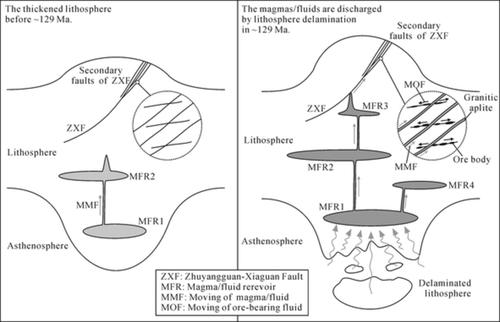当前位置:
X-MOL 学术
›
Geolog. J.
›
论文详情
Our official English website, www.x-mol.net, welcomes your
feedback! (Note: you will need to create a separate account there.)
Early Cretaceous granitic aplite in the Gaozhuang gold deposit, northern Qinling Orogenic Belt, central China: Implications for petrogenesis and metallogenesis
Geological Journal ( IF 1.4 ) Pub Date : 2021-04-07 , DOI: 10.1002/gj.4139 Tao Liang 1, 2 , Ren Lu 1, 2 , Longming Li 3
Geological Journal ( IF 1.4 ) Pub Date : 2021-04-07 , DOI: 10.1002/gj.4139 Tao Liang 1, 2 , Ren Lu 1, 2 , Longming Li 3
Affiliation

|
Petrogenesis of the Gaozhuang granitic aplites (GZGA) plays an important role in understanding the regional tectonic evolution and metallogenesis of the Gaozhuang gold deposit (GZGD) in the northern Qinling orogenic belt (NQOB). Here, we present new zircon U–Pb dating on two granitic aplite samples yielding a 25-zircon grain weighted average age of 129 ± 1 Ma (MSWD = 0.6), suggesting that GZGA formed in the Early Cretaceous. Major element results show that GZGA are: (a) characterized by higher SiO2 and alkali and lower MgO and CaO, belonging to the high-K calc–alkaline series; (b) enriched in large-ion lithophile elements and depleted in high-field-strength elements, which show negative spider–diagram anomalies of Nb, Ta, P, and Ti; (c) enriched in light rare earth elements and depleted in heavy rare earth elements without obvious Eu negative anomalies and (La/Yb) N ratios ranging from 71.9–107. GZGA compositional variation is controlled mainly by source composition and degree of partial melting and suggests no obvious relationship with fractional crystallization. GZGA samples belongs to the adakite, showing higher Sr (346–528 ppm), lower in Y (4.71–5.67 ppm) and Yb (0.26–0.33 ppm), and Sr/Y ratios of 63.5–93.2, indicating that GZGA originated from partial melting of the thickened lower crust (source depth >50 km) with residual phases of garnet, rutile, and insignificant plagioclase. Results find that GZGA is a product of the Early Cretaceous regional lithosphere delamination, in which Gaozhuang area adakitic aplite magmas and ore-bearing fluids were discharged nearly simultaneously, and the mixed magma–fluid systems crystallized, forming GZGA and GZGD, while rapidly ascending to the shallow crust along faults. Using GZGA, a prospecting indicator, we infer that the deep part of the GZGD should possess endogenetic Au metallogenic potential.
更新日期:2021-04-07











































 京公网安备 11010802027423号
京公网安备 11010802027423号